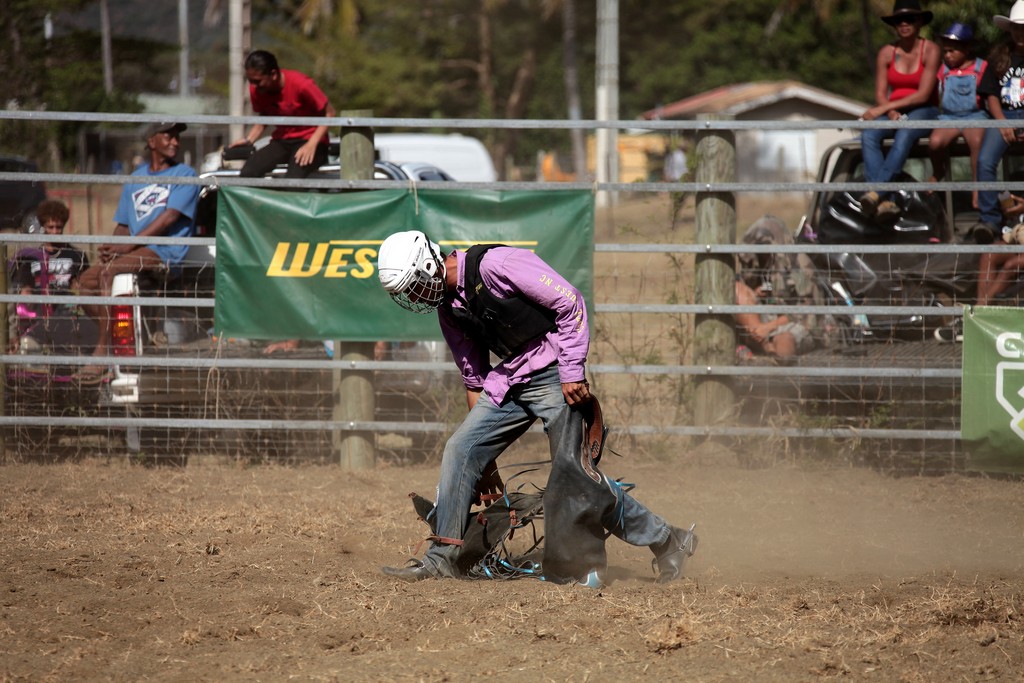BULL RIDER CHAPS RODEO
Chaps are sturdy coverings for the legs consisting of leggings and a belt. They are buckled on over trousers with the chaps' integrated belt, but unlike trousers they have no seat and are not joined at the crotch. They are designed to provide protection for the legs and are usually made of leather or a leather-like material. They are most commonly associated with the cowboy culture of the American west as a protective garment to be used when riding a horse through brushy terrain. In the modern world, they are worn for both practical work purposes and for exhibition or show use.
History
The earliest form of protective leather garment used by mounted riders who herded cattle in Spain and Mexico were called armas, which meant "shields." They were essentially two large pieces of cowhide that were used as a protective apron of sorts. They attached to the horn of the rider's stock saddle, and were spread across both the horse's chest and the rider's legs. From this early and rather cumbersome design came modifications that placed the garment entirely on the rider, and then style variations adapted as vaqueros, and later cowboys, moved up from Mexico into the Pacific coast and northern Rockies of what today is the United States and Canada. There is also evidence that certain design features may also descend from the mountain men, who copied them from the leggings worn by Native Americans. Different styles developed to fit the local climate, terrain and hazards. Designs were also modified for purely stylistic and decorative purposes. The time of actual appearance of the garment on American cowboys is uncertain. By the late 1870s, however, most Texas cowboys wore them as the cattle industry moved north. By 1884, the Dictionary of American Regional English notes use of the word in Wyoming, spelled "schaps."
The earliest form of protective leather garment used by mounted riders who herded cattle in Spain and Mexico were called armas, which meant "shields." They were essentially two large pieces of cowhide that were used as a protective apron of sorts. They attached to the horn of the rider's stock saddle, and were spread across both the horse's chest and the rider's legs. From this early and rather cumbersome design came modifications that placed the garment entirely on the rider, and then style variations adapted as vaqueros, and later cowboys, moved up from Mexico into the Pacific coast and northern Rockies of what today is the United States and Canada. There is also evidence that certain design features may also descend from the mountain men, who copied them from the leggings worn by Native Americans. Different styles developed to fit the local climate, terrain and hazards. Designs were also modified for purely stylistic and decorative purposes. The time of actual appearance of the garment on American cowboys is uncertain. By the late 1870s, however, most Texas cowboys wore them as the cattle industry moved north. By 1884, the Dictionary of American Regional English notes use of the word in Wyoming, spelled "schaps."
Batwing chaps are cut wide with a flare at the bottom. Generally made of smooth leather, they have only two or three fasteners around the thigh, thus allowing great freedom of movement for the lower leg. This is helpful when riding very actively, and makes it easier to mount the horse. This design also provides more air circulation and is thus somewhat cooler for hot-weather wear. Batwing chaps are often seen on rodeo contestants, particularly those who ride bucking stock. They are also seen on working ranches, particularly in Texas. They were a later design, developed after the end of the open range. Although by definition the chaps that rodeo contestants wear are considered batwing chaps, contestants do not refer to them as batwings. They are simply called rodeo chaps. There are a few differences in design between working ranch batwing chaps and rodeo chaps. Rodeo chaps are usually more colorful and decorated, whereas ranch cowboys need toughness over style. Rodeo chaps have long flowing fringe which can be the same or a different color as the main body. Ranch chaps may be customized with a brand or initials and some floral tooling, but never have fringe.
